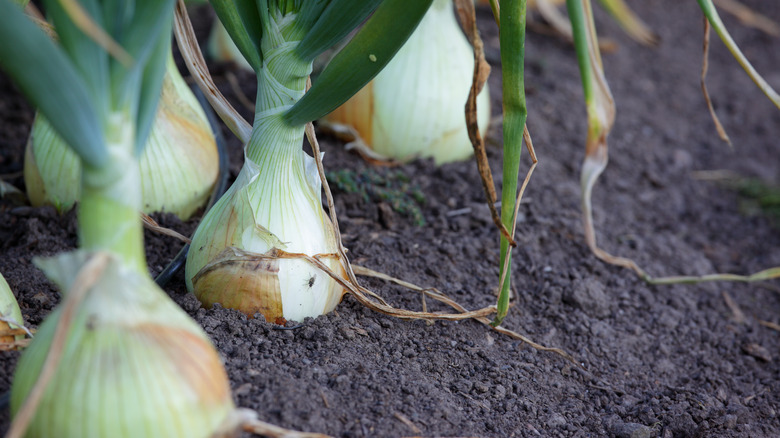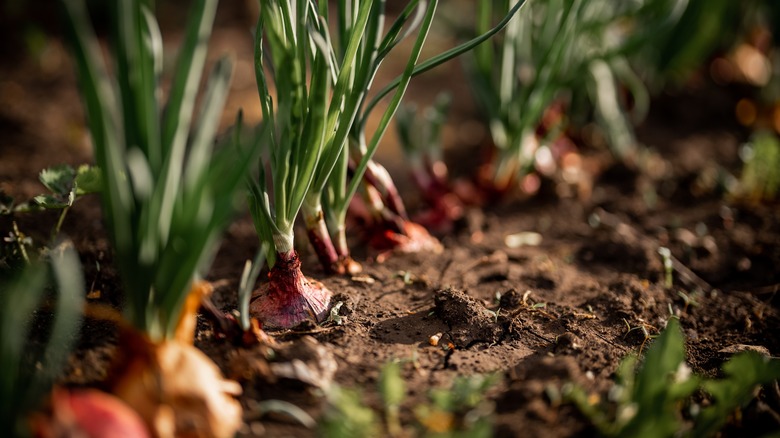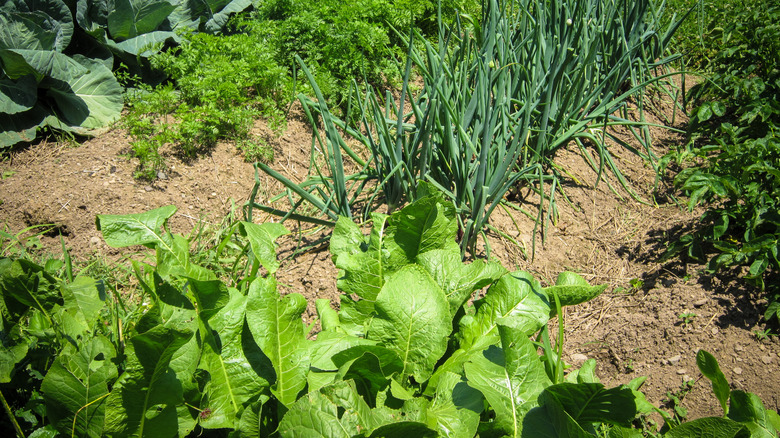The Crucial Mistake You Should Avoid When Growing Onions
Growing onions can be an excellent way to add versatility to the garden, and it doesn't have to be challenging if you know a bit about what onions need. The most important factor is sunlight, with some varieties demanding 16 or more hours of sunlight each day. Most onions, called short-day onions, do well with 11 to 12 hours of light. If you don't know how much sunlight your particular variety needs and don't create the ideal environment for maximum sunlight, it could cost you not just onion development but even its great flavor. Sun is the energy that plants like onions need to develop larger bulbs, which are the onions you enjoy. The more sunlight the plants receive, the larger the potential for bigger onions, though species also play a role.
You may have onion plants that grow well and create beautiful leaves that look healthy. Then, when removing the onions, you're instantly disappointed because they are tiny or seem to be undergrown. Even if you're sure it's time to harvest onions, this can happen. If you've planted onions in an area where they cannot get enough of the sunlight they demand, that will limit the leaves' ability to absorb enough energy to produce the bulb. While you cannot control those cloudy days, there are a few ways you can ensure you make the most of the sunlight your plants need.
Choose the right variety of onion for your area
The type of onion you decide to plant should be based on the amount of sunlight in your area during the average growing season. Long-day onions won't put energy into growing their bulbs until the length of the day reaches 14 hours or more. Living in an area where 14 hours of daylight doesn't happen until summer will limit the amount of growth the plant can do. Short-day onions require less sunlight to start producing bulbs. These onions will begin developing onion bulbs around 10 hours of daylight. Some onions are intermediates and fall between this range and need 12 to 14 hours of daylight.
There are dozens of varieties of onions to choose from, all of which are direct light-dependent to some degree. For long-day length onions, which have more time to grow leaves to produce bulbs, choose varieties like 'Early Yellow Globe,' 'Ebenezer,' and 'White Sweet Spanish' onions. Most long-day onions are grown in northern areas, with planting in the early fall and harvesting in the late summer. Short-day onions include options like Vidalia and 'Million Dollar Baby.' These often are grown in southern areas of the country because they start to grow sooner. That usually allows for harvesting to begin in spring. Intermediate onions include options like 'Superstar' onions and sweet red onions. Typically, intermediate onions are planted in the fall to allow for harvesting around the start of summer.
Create a sunlight-supportive environment for onions
Onions are a fantastic crop to grow in a home garden, but getting the conditions right is critical. They need certain well-draining soil boosted with organic material. No matter how you grow them, though, from seed, small bulbs, or transplants, you need to ensure they are placed in the garden in such a way as to allow for ample light. One key factor to consider is companion planting other vegetables with onions. If you place taller plants in the way of direct sunlight, that's going to create limitations on the bulb development of your onions. Choose lower-growing companion plants instead, such as carrots, leeks, cabbage, or lettuce, to place in the path of direct sunlight for the plant. These should not create too much shade to hinder the onion's leaf growth or bulb development. Place vegetables that get taller, like corn or tomatoes, in areas where their height will not impact the sunlight your onion plants need.
You also don't want to crowd them on each other, as that can also lead to airflow and growth. If placing seeds, keep them at least an inch apart and then thin them out to one plant every 3 inches as they start to grow. Wait until they reach about 6 inches before thinning so you can choose the healthiest options. Avoiding these mistakes when growing onions can help you get more of a robust, consistent level of growth.


